fuel Lancia Ypsilon 2002 Owner handbook (in English)
[x] Cancel search | Manufacturer: LANCIA, Model Year: 2002, Model line: Ypsilon, Model: Lancia Ypsilon 2002Pages: 191, PDF Size: 2.45 MB
Page 70 of 191
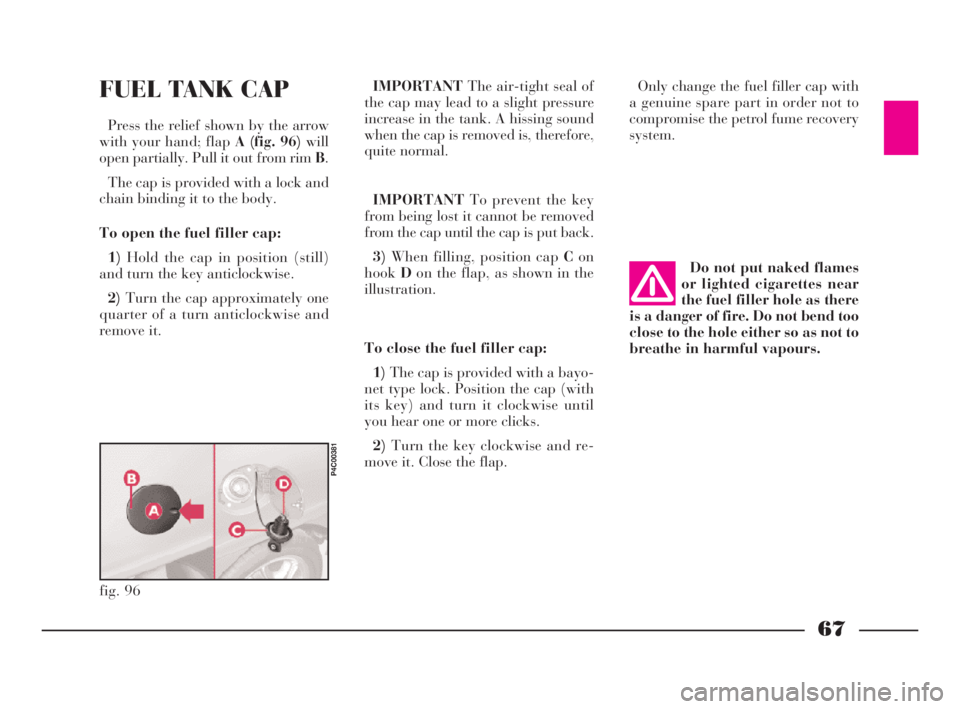
67
G
Only change the fuel filler cap with
a genuine spare part in order not to
compromise the petrol fume recovery
system.FUEL TANK CAP
Press the relief shown by the arrow
with your hand; flapA (fig. 96)will
open partially. Pull it out from rim B.
The cap is provided with a lock and
chain binding it to the body.
To open the fuel filler cap:
1)Hold the cap in position (still)
and turn the key anticlockwise.
2)Turn the cap approximately one
quarter of a turn anticlockwise and
remove it.IMPORTANTThe air-tight seal of
the cap may lead to a slight pressure
increase in the tank. A hissing sound
when the cap is removed is, therefore,
quite normal.
IMPORTANTTo prevent the key
from being lost it cannot be removed
from the cap until the cap is put back.
3)When filling, position cap Con
hookDon the flap, as shown in the
illustration.
To close the fuel filler cap:
1)The cap is provided with a bayo-
net type lock. Position the cap (with
its key) and turn it clockwise until
you hear one or more clicks.
2)Turn the key clockwise and re-
move it. Close the flap.Do not put naked flames
or lighted cigarettes near
the fuel filler hole as there
is a danger of fire. Do not bend too
close to the hole either so as not to
breathe in harmful vapours.
fig. 96
P4C00381
4C001-067 ING 11-03-2008 11:57 Pagina 67
Page 73 of 191

70
G
HOW TO WARM UP
THE ENGINE AFTER
IT HAS JUST STARTED
– Begin to move forward slowly let-
ting the engine turn over at medium
revs. Do not accelerate abruptly.
– Do not push the engine to its limit
for the first few kilometres. You are
recommended to wait until the water
temperature has reached 50°C to
60°C (pointer moves slightly from its
initial position).
EMERGENCY STARTING
If the Lancia CODE system fails to
recognise the code transmitted by the
ignition key (warning lamp ¢on in-
strument panel lit with a fixed light),
you can start the engine by following
the emergency procedure using the
code written on the CODE card.
See the section “In an emergency”.STOPPING THE ENGINE
Turn the ignition key to STOPwhile
the engine is idling.
Remember that as long as
the engine is not running,
the brake booster and
power steering do not work. You
therefore have to use considerably
more effort on both the brake
pedal and the steering wheel.
Bump starting by push-
ing, towing or rolling
downhill must be avoided
at all costs. This way of starting
could cause a rush of fuel into the
catalytic exhaust pipe and damage
it beyond repair.
BUMP STARTING
A quick burst on the ac-
celerator before turning off
the engine serves ab-
solutely no practical purpose, and
wastes fuel.
IMPORTANTAfter a taxing drive it
is better to allow the engine to “catch
its breath” before turning it off by let-
ting it idle to allow the temperature in
the engine compartment to fall.
4C068-089 ING 11-03-2008 11:59 Pagina 70
Page 76 of 191
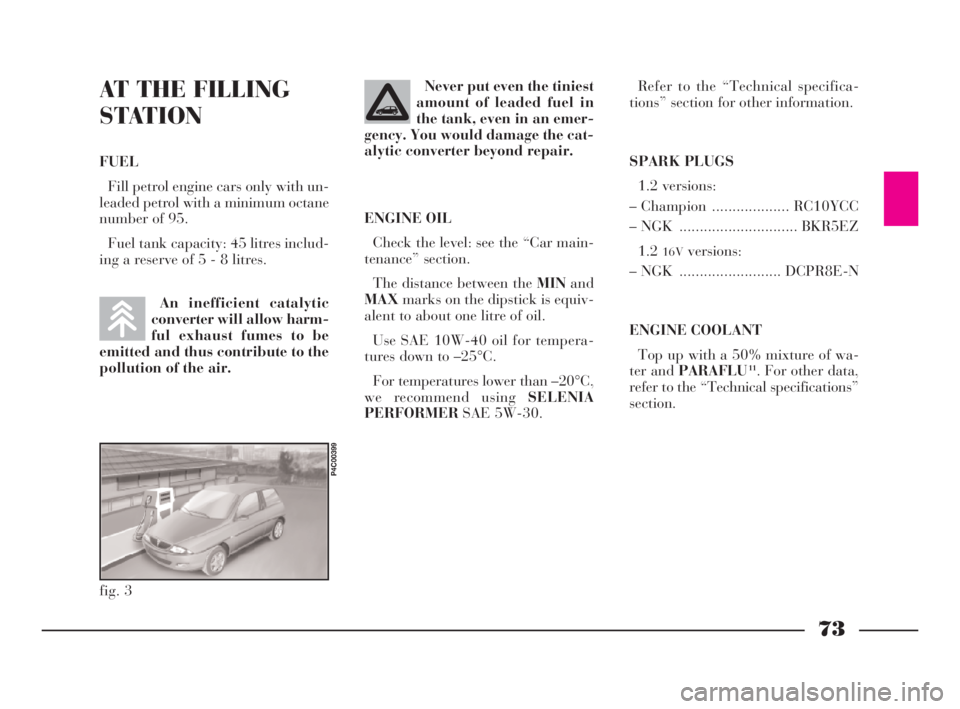
73
G
AT THE FILLING
STATION
FUEL
Fill petrol engine cars only with un-
leaded petrol with a minimum octane
number of 95.
Fuel tank capacity: 45 litres includ-
ing a reserve of 5 - 8 litres.Never put even the tiniest
amount of leaded fuel in
the tank, even in an emer-
gency. You would damage the cat-
alytic converter beyond repair.
ENGINE OIL
Check the level: see the “Car main-
tenance” section.
The distance between the MINand
MAXmarks on the dipstick is equiv-
alent to about one litre of oil.
Use SAE 10W-40 oil for tempera-
tures down to –25°C.
For temperatures lower than –20°C,
we recommend using SELENIA
PERFORMERSAE 5W-30.Refer to the “Technical specifica-
tions” section for other information.
SPARK PLUGS
1.2 versions:
– Champion ................... RC10YCC
– NGK ............................. BKR5EZ
1.2
16Vversions:
– NGK ......................... DCPR8E-N
ENGINE COOLANT
Top up with a 50% mixture of wa-
ter and PARAFLU
11. For other data,
refer to the “Technical specifications”
section.
An inefficient catalytic
converter will allow harm-
ful exhaust fumes to be
emitted and thus contribute to the
pollution of the air.
fig. 3
P4C00399
4C068-089 ING 11-03-2008 11:59 Pagina 73
Page 84 of 191
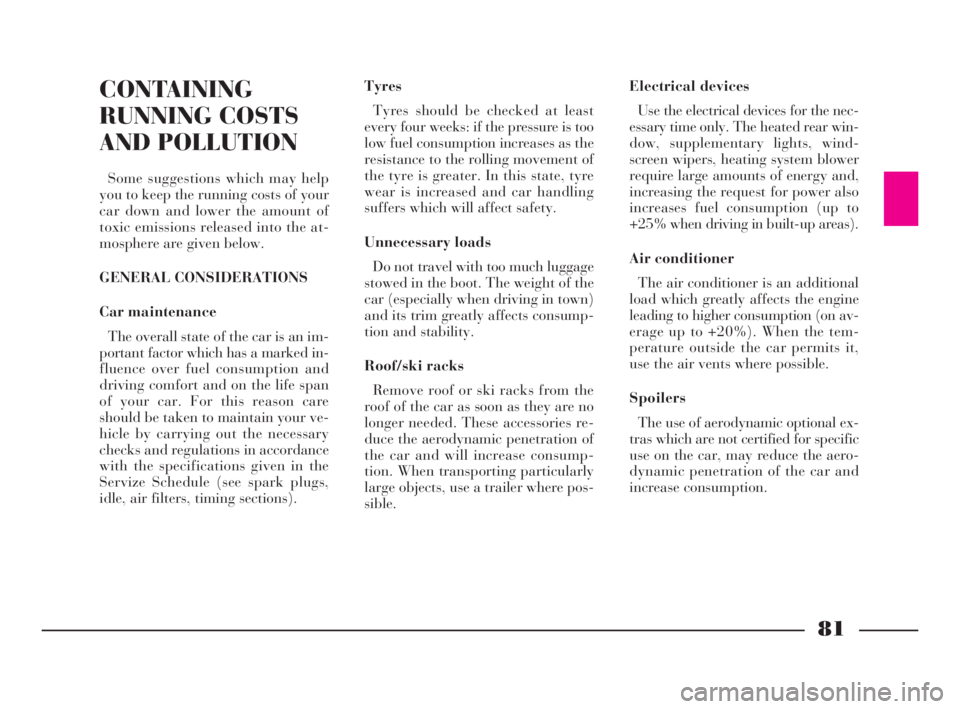
81
G
CONTAINING
RUNNING COSTS
AND POLLUTION
Some suggestions which may help
you to keep the running costs of your
car down and lower the amount of
toxic emissions released into the at-
mosphere are given below.
GENERAL CONSIDERATIONS
Car maintenance
The overall state of the car is an im-
portant factor which has a marked in-
fluence over fuel consumption and
driving comfort and on the life span
of your car. For this reason care
should be taken to maintain your ve-
hicle by carrying out the necessary
checks and regulations in accordance
with the specifications given in the
Servize Schedule (see spark plugs,
idle, air filters, timing sections).Tyres
Tyres should be checked at least
every four weeks: if the pressure is too
low fuel consumption increases as the
resistance to the rolling movement of
the tyre is greater. In this state, tyre
wear is increased and car handling
suffers which will affect safety.
Unnecessary loads
Do not travel with too much luggage
stowed in the boot. The weight of the
car (especially when driving in town)
and its trim greatly affects consump-
tion and stability.
Roof/ski racks
Remove roof or ski racks from the
roof of the car as soon as they are no
longer needed. These accessories re-
duce the aerodynamic penetration of
the car and will increase consump-
tion. When transporting particularly
large objects, use a trailer where pos-
sible.Electrical devices
Use the electrical devices for the nec-
essary time only. The heated rear win-
dow, supplementary lights, wind-
screen wipers, heating system blower
require large amounts of energy and,
increasing the request for power also
increases fuel consumption (up to
+25% when driving in built-up areas).
Air conditioner
The air conditioner is an additional
load which greatly affects the engine
leading to higher consumption (on av-
erage up to +20%). When the tem-
perature outside the car permits it,
use the air vents where possible.
Spoilers
The use of aerodynamic optional ex-
tras which are not certified for specific
use on the car, may reduce the aero-
dynamic penetration of the car and
increase consumption.
4C068-089 ING 11-03-2008 11:59 Pagina 81
Page 85 of 191

82
G
Gear selection
As soon as the traffic and road con-
ditions allow it, shift to a higher gear.
Using a lower gear to liven up accel-
eration greatly increases consumption.
In the same way, improper use of the
higher gears will increase consump-
tion, emissions and wear and tear on
the engine.
Top speeds
Fuel consumption increases consid-
erably as speed increases. For exam-
ple, when accelerating from 90 to
120 kph, fuel consumption increases
by about +30%. Your speed should
be kept as even as possible and su-
perfluous braking and acceleration
avoided as this increases both con-
sumption and emissions. A “soft” way
of driving should be adopted by at-
tempting to anticipate manoeuvres to
avoid imminent danger and to keep a
safe distance from the vehicle in front
in order to avoid braking sharply.Acceleration
Accelerating violently increasing the
revs will greatly affect consumption
and emissions: acceleration should be
gradual and not exceed the maximum
torque.
CONDITIONS OF USE
Cold starting
Frequent cold starting will not en-
able the engine to reach optimal run-
ning temperature. It follows therefore
that consumption will be higher (from
+15% to +30% in built-up areas) as
will the production of toxic emissions. STYLE OF DRIVING
Starting
Do not warm the engine when the
car is stationery or at high or low revs:
in this way the engine will warm up
gradually increasing consumption and
emissions. You should drive off slowly
straight away avoiding high revs so
that the engine will warm up more
quickly.
Unnecessary actions
Avoid revving the engine when
stopped at traffic lights or before
switching off the engine and avoid
doubling the clutch as these actions
have no purpose on modern vehicles
and serve only to increase consump-
tion and pollution.
4C068-089 ING 11-03-2008 11:59 Pagina 82
Page 86 of 191

83
G
Traffic and road conditions
Heavy traffic and higher consump-
tion are synonymous; for example,
when driving slowly with frequent use
of the lower gears or in large towns
where there are numerous traffic
lights.
Winding roads, mountain roads and
bumpy roads also have a negative ef-
fect on consumption.
Enforced halts
During prolonged hold-ups (traffic
lights, level crossings) the engine
should be switched off.LOOKING AFTER EMISSION
CONTROL DEVICES
The correct use of pollution control
devices not only ensures respect for
the environment but also has an effect
on the car’s performance. Keeping
these devices in good condition is
therefore a fundamental rule for dri-
ving that is easy on your pocket and
on the environment too.
The first step to take is to follow the
Service Schedule to the letter.
Use only unleaded petrol.
If you have trouble starting, do not
keep turning the ignition key for long
periods. Be especially careful to avoid
bump starting the car by pushing,
towing or rolling down hill: these are
all manoeuvres that can damage the
catalytic exhaust.CHEAP RUNNING
THAT RESPECTS
THE ENVIRONMENT
Environmental protection has been
one of the guiding principles in the
production of the Lancia Y. It is no ac-
cident that its pollution control equip-
ment is much more effective than that
required by current legislation.
Nonetheless, the environment can-
not get by without a concerted effort
from everyone.
By following a few simple rules you
can avoid harming the environment
and often cut down fuel consumption
at the same time.
On this subject, a few useful tips
have been given below to supplement
those marked by symbol #at various
points of the handbook.
You are asked to read both the for-
mer and latter carefully.
4C068-089 ING 11-03-2008 11:59 Pagina 83
Page 87 of 191
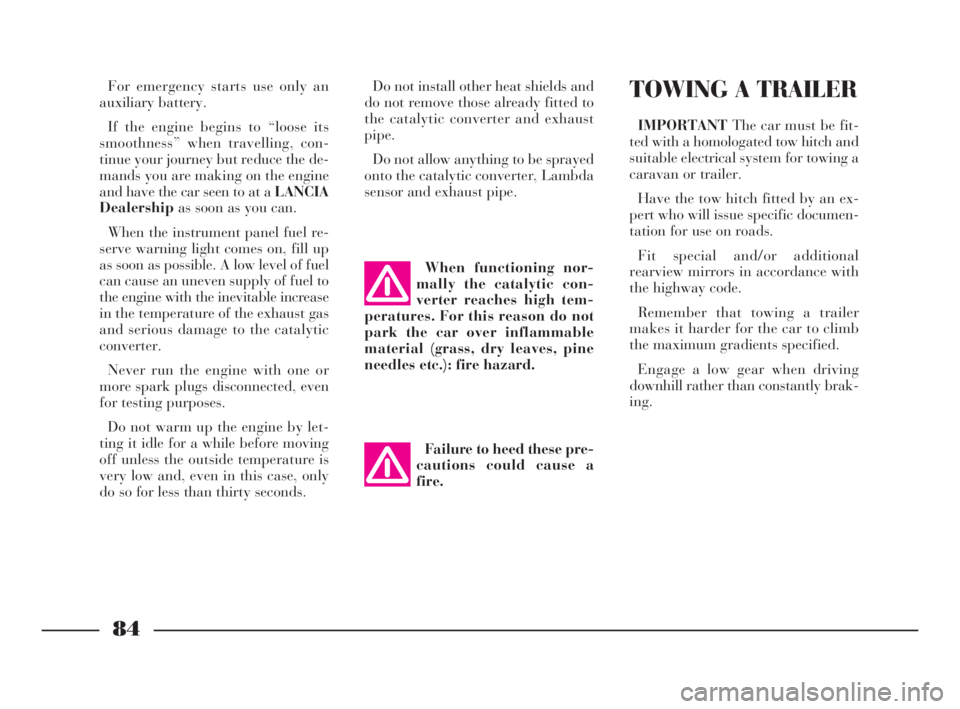
84
G
For emergency starts use only an
auxiliary battery.
If the engine begins to “loose its
smoothness” when travelling, con-
tinue your journey but reduce the de-
mands you are making on the engine
and have the car seen to at a LANCIA
Dealershipas soon as you can.
When the instrument panel fuel re-
serve warning light comes on, fill up
as soon as possible. A low level of fuel
can cause an uneven supply of fuel to
the engine with the inevitable increase
in the temperature of the exhaust gas
and serious damage to the catalytic
converter.
Never run the engine with one or
more spark plugs disconnected, even
for testing purposes.
Do not warm up the engine by let-
ting it idle for a while before moving
off unless the outside temperature is
very low and, even in this case, only
do so for less than thirty seconds.When functioning nor-
mally the catalytic con-
verter reaches high tem-
peratures. For this reason do not
park the car over inflammable
material (grass, dry leaves, pine
needles etc.): fire hazard.
Failure to heed these pre-
cautions could cause a
fire.
Do not install other heat shields and
do not remove those already fitted to
the catalytic converter and exhaust
pipe.
Do not allow anything to be sprayed
onto the catalytic converter, Lambda
sensor and exhaust pipe.TOWING A TRAILER
IMPORTANTThe car must be fit-
ted with a homologated tow hitch and
suitable electrical system for towing a
caravan or trailer.
Have the tow hitch fitted by an ex-
pert who will issue specific documen-
tation for use on roads.
Fit special and/or additional
rearview mirrors in accordance with
the highway code.
Remember that towing a trailer
makes it harder for the car to climb
the maximum gradients specified.
Engage a low gear when driving
downhill rather than constantly brak-
ing.
4C068-089 ING 11-03-2008 11:59 Pagina 84
Page 96 of 191

93
G
Under no circumstances
should a battery charger
be used to start the engine:
it could damage the electronic sys-
tems and in particular the control
units governing ignition and fuel
feed.Do not carry out this pro-
cedure if you lack experi-
ence; if it is not done cor-
rectly it can cause very intense
electrical discharges and the bat-
tery might even explode. In addi-
tion, the fluid contained in the bat-
tery is poisonous and corrosive.
Avoid contact with skin and eyes.
You are also advised not to putnaked flames or lighted cigarettes
near the battery and not to cause
sparks: risk of fire and explosion.
To avoid damage to the
electrical system, scrupu-
lously follow the cable
manufacturer’s instructions. Make
sure the cables have an adequate
cross section and are long enough
to avoid the two car touching.
4C090-119 ING 11-03-2008 12:00 Pagina 93
Page 97 of 191

94
G
into the catalytic exhaust
pipe and damage it beyond
repair.
BUMP
STARTING
Bump starting by pushing, towing
or rolling downhill must be
avoided at all costs. This way of
starting could cause a rush of fuelRemember that as long as
the engine is not running,
the brake booster and
power steering do not work. You
therefore have to use considerably
more effort on both the brake
pedal and the steering wheel.
IF A TYRE
IS
PUNCTURED
GENERAL INDICATIONS
The following precautions must be
observed when changing a wheel and
using the jack and the space-saver
spare wheel.
4C090-119 ING 11-03-2008 12:00 Pagina 94
Page 116 of 191
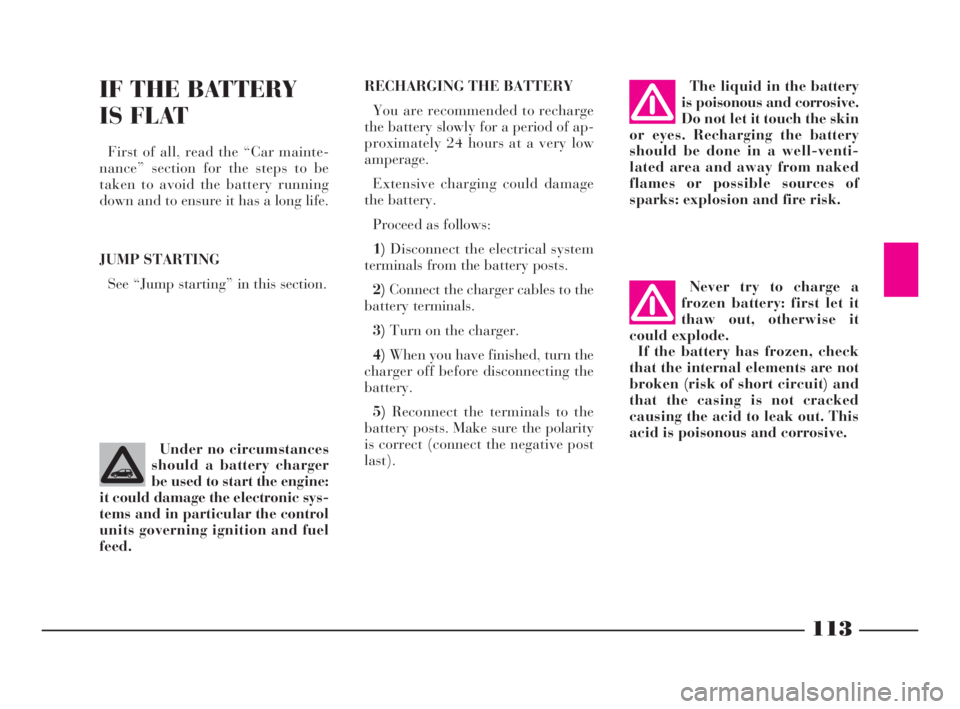
113
fG
RECHARGING THE BATTERY
You are recommended to recharge
the battery slowly for a period of ap-
proximately 24 hours at a very low
amperage.
Extensive charging could damage
the battery.
Proceed as follows:
1)Disconnect the electrical system
terminals from the battery posts.
2)Connect the charger cables to the
battery terminals.
3)Turn on the charger.
4)When you have finished, turn the
charger off before disconnecting the
battery.
5)Reconnect the terminals to the
battery posts. Make sure the polarity
is correct (connect the negative post
last).IF THE BATTERY
IS FLAT
First of all, read the “Car mainte-
nance” section for the steps to be
taken to avoid the battery running
down and to ensure it has a long life.
JUMP STARTING
See “Jump starting” in this section.The liquid in the battery
is poisonous and corrosive.
Do not let it touch the skin
or eyes. Recharging the battery
should be done in a well-venti-
lated area and away from naked
flames or possible sources of
sparks: explosion and fire risk.
Never try to charge a
frozen battery: first let it
thaw out, otherwise it
could explode.
If the battery has frozen, check
that the internal elements are not
broken (risk of short circuit) and
that the casing is not cracked
causing the acid to leak out. This
acid is poisonous and corrosive.
Under no circumstances
should a battery charger
be used to start the engine:
it could damage the electronic sys-
tems and in particular the control
units governing ignition and fuel
feed.
4C090-119 ING 13-03-2008 12:51 Pagina 113